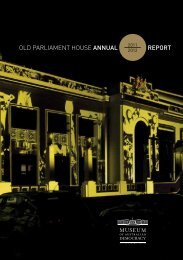OLD PARLIAMENT HOUSE AND CURTILAGE HERITAGE MANAGEMENT PLAN 2008–2013
Heritage Management Plan 2008-2013 - Museum of Australian ...
Heritage Management Plan 2008-2013 - Museum of Australian ...
- No tags were found...
You also want an ePaper? Increase the reach of your titles
YUMPU automatically turns print PDFs into web optimized ePapers that Google loves.
D. History of the Place<br />
Part D – Appendices<br />
302 Old Parliament House and Curtilage Heritage Management Plan <strong>2008–2013</strong><br />
1985 The National Capital Development Commission bespoke the first conservation management<br />
plan on the recommendation from the Joint Standing Committee to assist in the decision making<br />
process for the future use of OPH. This plan was largely based on the architectural values of<br />
the building and recommended that all post-1927 additions and alterations be removed.<br />
1987 Old Parliament House was entered on the Register of the National Estate.<br />
c1990 A Good Weekend article quotes Billy Snedden stating in 1985 to blow up the old house when it<br />
fell empty. Also in this article Gough Whitlam says “What are you going to keep? The historic building is<br />
much smaller than the additions. Obviously you have to keep the steps.” Bill Hayden stated that it should<br />
be restored to its 1927 configuration incorporating public access and a museum of Federation. Oodgeroo<br />
Noonuccal (Kath Walker) recommended that the building be turned over to the Aboriginal Embassy.<br />
1992 The Joint Standing Committee on the Parliamentary Zone stated that “as Australia<br />
moves towards its 100 years of Federation there could be no more fitting way to commemorate<br />
the significance of Federation than by restoring Old Parliament House to remind Australia<br />
of the developments that have taken place during those first 100 years.”<br />
The Federal Government decided to implement a new single management authority for Old Parliament<br />
House within the former Department of Communications, Information Technology and the Arts (DCITA).<br />
As part of the process of transferring the management of Old Parliament House from the Department of<br />
Administrative Services to DCITA, a second conservation management plan aimed to clarify the significance of<br />
the building was completed. This plan contained six broad policies. No further research was undertaken for<br />
this plan and it recommends superficial preservation of 1927-1988 building fabric. The Australian Heritage<br />
Council stated at this time that the question of removing either of the wings was a major matter of contention.<br />
During this decade of uncertainty, two conservation management plans were prepared for Old Parliament<br />
House. This uncertainty of the role and function for the place ultimately led to uncertainty surrounding<br />
the place’s heritage values. The first conservation management plan in 1986 advocated the removal of all<br />
additions to the building since its opening in 1927. Some activities and building works undertaken during this<br />
period compromised the heritage values irrevocably. These activities/works included: expatriation of furniture;<br />
Members’ Dining Room refurbishment and new commercial kitchen; and the Non-Members Bar refurbishment.<br />
In 1996, the second conservation management plan advocated the retention of the 1988 configuration of<br />
Old Parliament House to ensure the full story of the evolution of the provisional parliament house can be told<br />
but recommended that large tracts of the building need only have exterior facades conserved to represent<br />
this significance. Building work during this conservation management plan included the South West Wing<br />
asbestos removal and refurbishment and the Parliamentary Library and Lower Library refurbishment.<br />
2000 The Conservation Management Plan (CMP) 2000 completed, a significant evolution from the two<br />
preceding plans. For the first time conservation planning at OPH was developed as an integral management tool<br />
with the subsequent plan the primary reference document for decision making. The plan outlined 46 specific<br />
policies covering issues such as training, building works, use of the place, interpretation and movable heritage.<br />
The CMP2000 clearly stated the significance of the place being founded in the building’s<br />
full life as the home of federal parliament and that significance must guide and inform<br />
decision making. The internal standard definitions for OPH consider the term ‘original’ to<br />
mean any heritage fabric, fitting or furnishing relating to the period 1923 to 1988. 83<br />
2000-06 A number of detailed heritage analyses on specific areas of the building were completed to augment<br />
the CMP2000 (see Appendix K). These studies assisted in the overall knowledge and understanding of<br />
the heritage values of the place and have provided valuable guidance during conservation and capital<br />
works projects which included the: North Wing roof refurbishment; the Members Private Dining Room<br />
refurbishment; and conservation work completed on the House of Representatives Press Offices.<br />
2003 Amendments to the Environment Protection Biodiversity Conservation Act 1999 came into effect,<br />
introducing the Commonwealth and National Heritage Lists and the Australian Heritage Council.<br />
CMP2000 policies reviewed in light of information in the heritage analyses completed since 2000.<br />
2004 Old Parliament House added to the Commonwealth Heritage List.<br />
2005 HMP 2005, a redraft of the CMP2000 (as amended in 2003) in line with new heritage legislation.<br />
2006 Old Parliament House added to the National Heritage List.<br />
New Heritage Management Plan drafted, informed by the HMP 2005.<br />
83 Construction commenced in 1923 and therefore elements of the early building fabric pre-date the official opening in May 1927.




